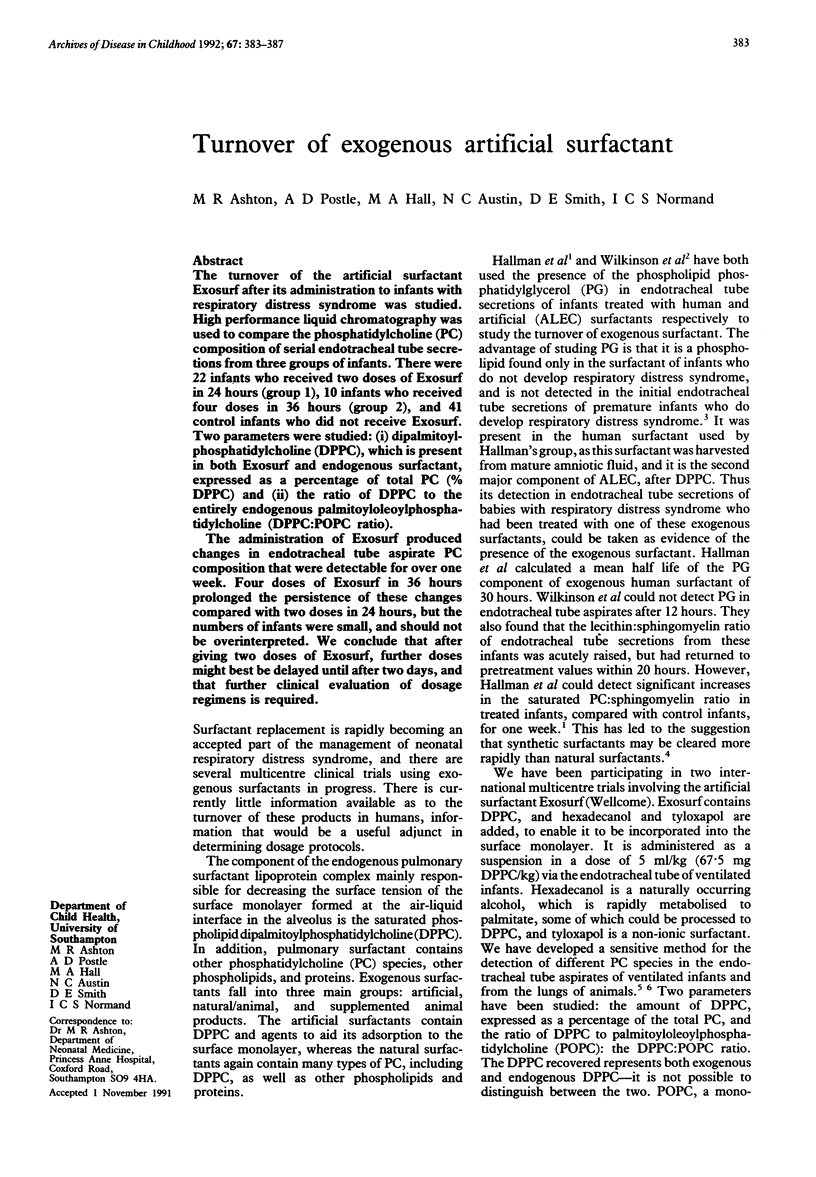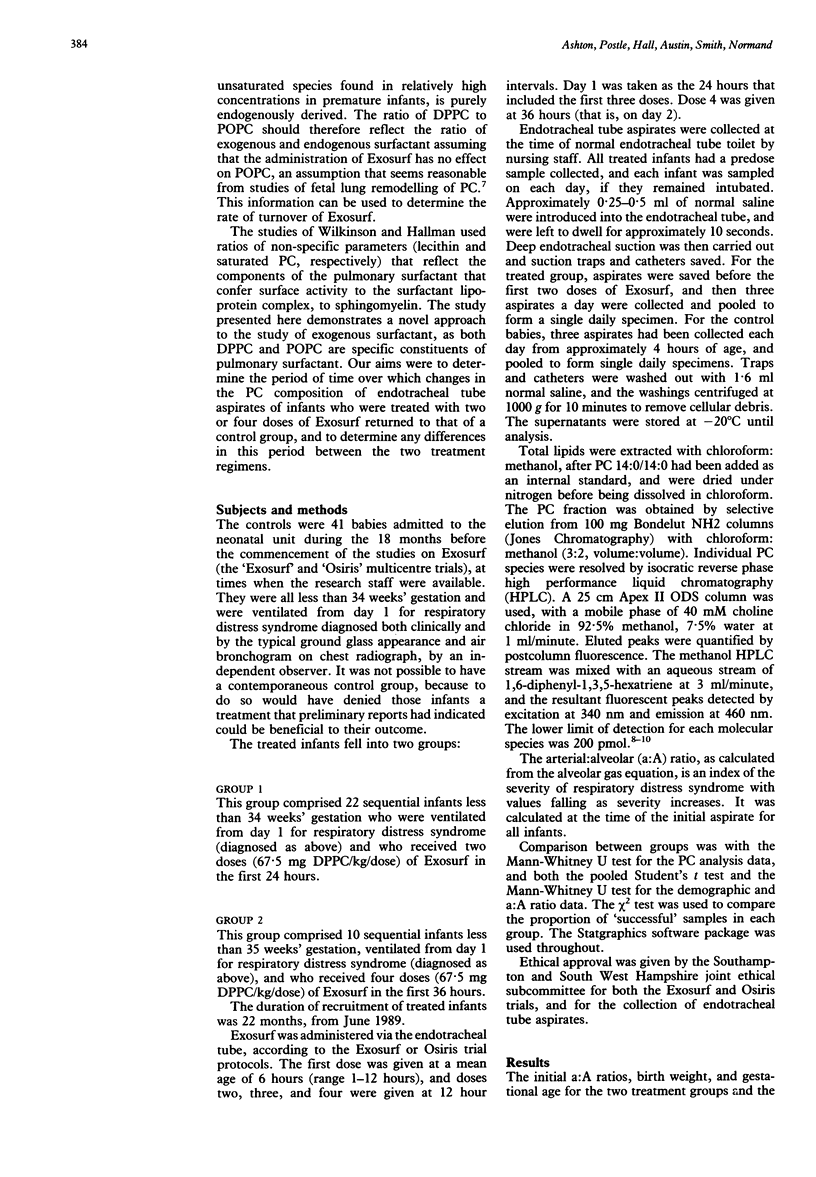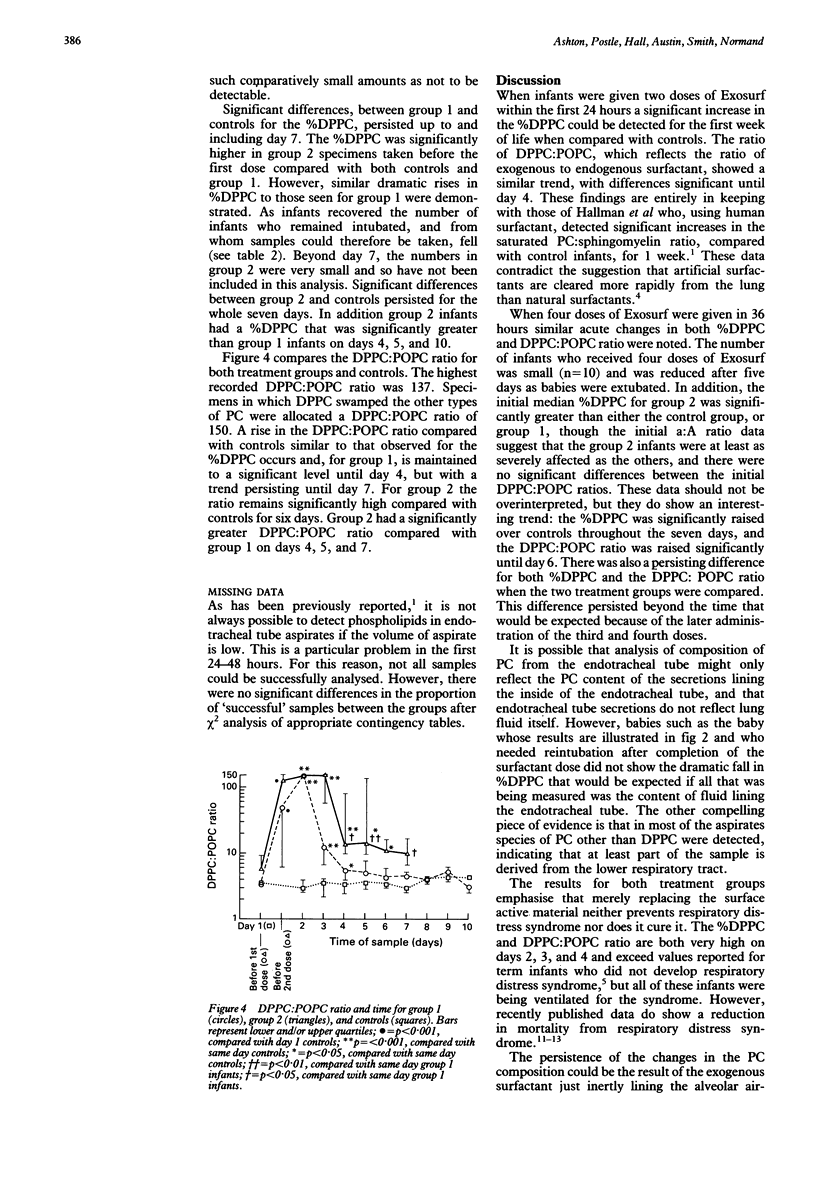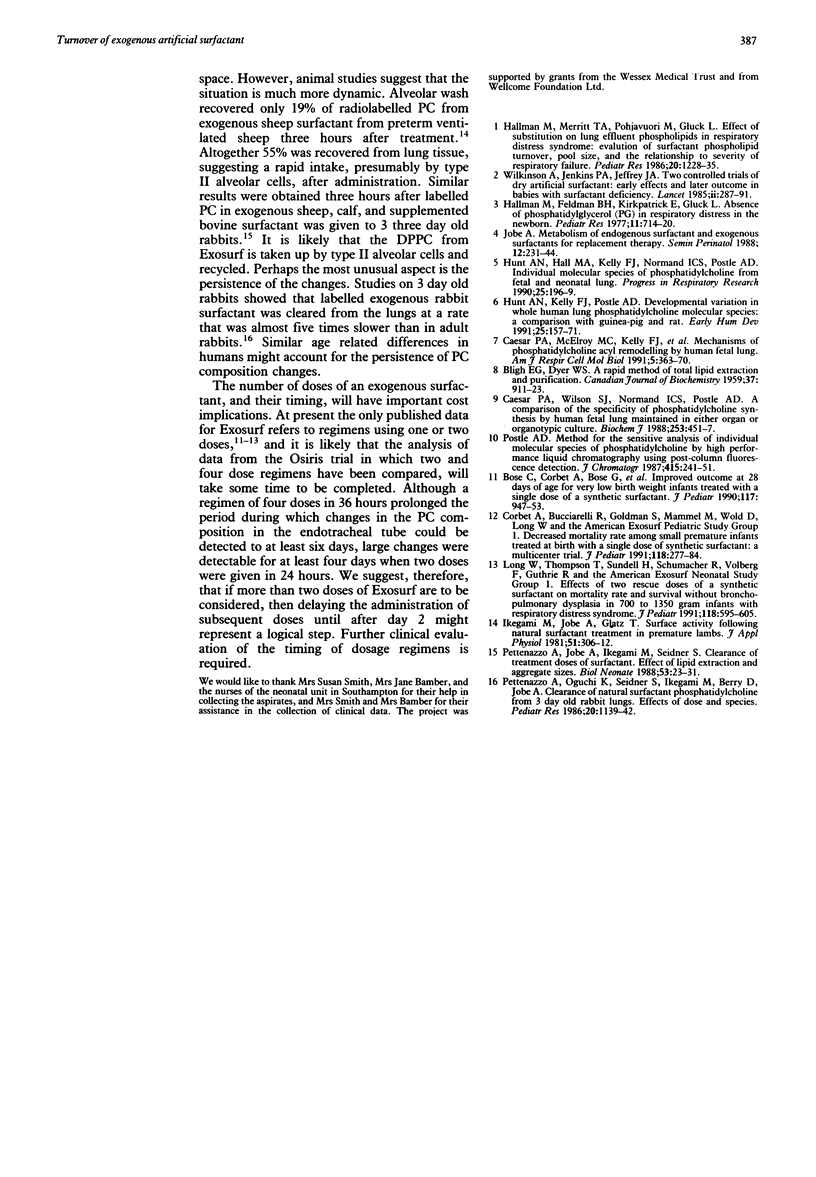Abstract
The turnover of the artificial surfactant Exosurf after its administration to infants with respiratory distress syndrome was studied. High performance liquid chromatography was used to compare the phosphatidylcholine (PC) composition of serial endotracheal tube secretions from three groups of infants. There were 22 infants who received two doses of Exosurf in 24 hours (group 1), 10 infants who received four doses in 36 hours (group 2), and 41 control infants who did not receive Exosurf. Two parameters were studied: (i) dipalmitoylphosphatidylcholine (DPPC), which is present in both Exosurf and endogenous surfactant, expressed as a percentage of total PC (% DPPC) and (ii) the ratio of DPPC to the entirely endogenous palmitoyloleoylphosphatidylcholine (DPPC:POPC ratio). The administration of Exosurf produced changes in endotracheal tube aspirate PC composition that were detectable for over one week. Four doses of Exosurf in 36 hours prolonged the persistence of these changes compared with two doses in 24 hours, but the numbers of infants were small, and should not be over-interpreted. We conclude that after giving two doses of Exosurf, further doses might best be delayed until after two days, and that further clinical evaluation of dosage regimens is required.
Full text
PDF




Selected References
These references are in PubMed. This may not be the complete list of references from this article.
- BLIGH E. G., DYER W. J. A rapid method of total lipid extraction and purification. Can J Biochem Physiol. 1959 Aug;37(8):911–917. doi: 10.1139/o59-099. [DOI] [PubMed] [Google Scholar]
- Bose C., Corbet A., Bose G., Garcia-Prats J., Lombardy L., Wold D., Donlon D., Long W. Improved outcome at 28 days of age for very low birth weight infants treated with a single dose of a synthetic surfactant. J Pediatr. 1990 Dec;117(6):947–953. doi: 10.1016/s0022-3476(05)80143-x. [DOI] [PubMed] [Google Scholar]
- Caesar P. A., McElroy M. C., Kelly F. J., Normand I. C., Postle A. D. Mechanisms of phosphatidylcholine acyl remodeling by human fetal lung. Am J Respir Cell Mol Biol. 1991 Oct;5(4):363–370. doi: 10.1165/ajrcmb/5.4.363. [DOI] [PubMed] [Google Scholar]
- Caesar P. A., Wilson S. J., Normand C. S., Postle A. D. A comparison of the specificity of phosphatidylcholine synthesis by human fetal lung maintained in either organ or organotypic culture. Biochem J. 1988 Jul 15;253(2):451–457. doi: 10.1042/bj2530451. [DOI] [PMC free article] [PubMed] [Google Scholar]
- Corbet A., Bucciarelli R., Goldman S., Mammel M., Wold D., Long W. Decreased mortality rate among small premature infants treated at birth with a single dose of synthetic surfactant: a multicenter controlled trial. American Exosurf Pediatric Study Group 1. J Pediatr. 1991 Feb;118(2):277–284. doi: 10.1016/s0022-3476(05)80502-5. [DOI] [PubMed] [Google Scholar]
- Hallman M., Feldman B. H., Kirkpatrick E., Gluck L. Absence of phosphatidylglycerol (PG) in respiratory distress syndrome in the newborn. Study of the minor surfactant phospholipids in newborns. Pediatr Res. 1977 Jun;11(6):714–720. doi: 10.1203/00006450-197706000-00003. [DOI] [PubMed] [Google Scholar]
- Hallman M., Merritt T. A., Pohjavuori M., Gluck L. Effect of surfactant substitution on lung effluent phospholipids in respiratory distress syndrome: evaluation of surfactant phospholipid turnover, pool size, and the relationship to severity of respiratory failure. Pediatr Res. 1986 Dec;20(12):1228–1235. doi: 10.1203/00006450-198612000-00008. [DOI] [PubMed] [Google Scholar]
- Hunt A. N., Kelly F. J., Postle A. D. Developmental variation in whole human lung phosphatidylcholine molecular species: a comparison with guinea pig and rat. Early Hum Dev. 1991 Jun;25(3):157–171. doi: 10.1016/0378-3782(91)90112-g. [DOI] [PubMed] [Google Scholar]
- Ikegami M., Jobe A., Glatz T. Surface activity following natural surfactant treatment in premature lambs. J Appl Physiol Respir Environ Exerc Physiol. 1981 Aug;51(2):306–312. doi: 10.1152/jappl.1981.51.2.306. [DOI] [PubMed] [Google Scholar]
- Jobe A. Metabolism of endogenous surfactant and exogenous surfactants for replacement therapy. Semin Perinatol. 1988 Jul;12(3):231–244. [PubMed] [Google Scholar]
- Long W., Thompson T., Sundell H., Schumacher R., Volberg F., Guthrie R. Effects of two rescue doses of a synthetic surfactant on mortality rate and survival without bronchopulmonary dysplasia in 700- to 1350-gram infants with respiratory distress syndrome. The American Exosurf Neonatal Study Group I. J Pediatr. 1991 Apr;118(4 Pt 1):595–605. doi: 10.1016/s0022-3476(05)83388-8. [DOI] [PubMed] [Google Scholar]
- Pettenazzo A., Jobe A., Ikegami M., Seidner S. Clearance of treatment doses of surfactant. Effect of lipid extraction and aggregate sizes. Biol Neonate. 1988;53(1):23–31. doi: 10.1159/000242758. [DOI] [PubMed] [Google Scholar]
- Pettenazzo A., Oguchi K., Seidner S., Ikegami M., Berry D., Jobe A. Clearance of natural surfactant phosphatidylcholine from 3-day-old rabbit lungs: effects of dose and species. Pediatr Res. 1986 Nov;20(11):1139–1142. doi: 10.1203/00006450-198611000-00015. [DOI] [PubMed] [Google Scholar]
- Postle A. D. Method for the sensitive analysis of individual molecular species of phosphatidylcholine by high-performance liquid chromatography using post-column fluorescence detection. J Chromatogr. 1987 Apr 10;415(2):241–251. doi: 10.1016/s0378-4347(00)83216-8. [DOI] [PubMed] [Google Scholar]
- Wilkinson A., Jenkins P. A., Jeffrey J. A. Two controlled trials of dry artificial surfactant: early effects and later outcome in babies with surfactant deficiency. Lancet. 1985 Aug 10;2(8450):287–291. doi: 10.1016/s0140-6736(85)90346-0. [DOI] [PubMed] [Google Scholar]


